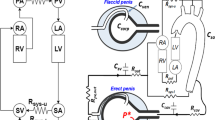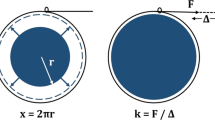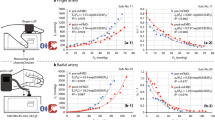Abstract
Today, in the assessment of cavernous artery blood-flow, the most commonly used technique is Doppler ultrasound velocimetry (continuous, pulsed, color-coded or power), which is often considered as the gold standard. Plethysmographic techniques and radioactive tracers have been widely used for the assessment of global penis flow variations but are not adequate for continuous blood-flow measurement. A new pulse-volume plethysmographic (PVP) device using a water-filled penile cuff was employed to assess continuous blood-flow measurement in the penis. Simultaneously Doppler velocity was recorded and served as a gold standard. A penile water-cuff is connected through a pressure tube to a three-way tap. The pulse-volume changes in the penile water-cuff are measured by means of a latex membrane placed over one of the three-way taps. The displacements of the latex are recorded by a photoplethysmograph. The third tap is connected to a 5 l perfusion bag placed 30 cm above the penis so as to maintain constant pressure in the whole device whatever the penis volume. Twenty-four volunteers were tested. The Doppler velocity signal and pulse volume of cavernous arteries were measured simultaneously after PGE1 intra-cavernous injection. Blood-flow variations were induced by increasing penis artery compression with a second penile water-cuff used as a tourniquet fitted onto the penis root, and the pressure of which could be modified by a water-filled syringe. The amplitude of the plethysmographic pulse-volume signal and the area under the Doppler velocity signal were correlated. The inter-patient (n=24) correlation ranged from 0.455 to 0.904, with a mean correlation of 0.704 and P<0.0001. PVP measurement by a water-filled cuff was validated by ultrasound velocimetry. This new continuous, non-invasive and easy-to-use technique enables physiological and physiopathological flow-measurement during sleep, under visual sexual stimulation (VSS), or following artificial erection. Simultaneous recording of penile blood-flow by PVP and intra-cavernous pressure (ICP) measured by a non-invasive device will provide fundamental inflow and outflow information in both physiological and pathophysiological conditions, and further enable venous leakage to be assessed by a mathematical model.
This is a preview of subscription content, access via your institution
Access options
Subscribe to this journal
Receive 8 print issues and online access
$259.00 per year
only $32.38 per issue
Buy this article
- Purchase on Springer Link
- Instant access to full article PDF
Prices may be subject to local taxes which are calculated during checkout



Similar content being viewed by others
References
Barnea O. . A theoretical unidirectional valve based on functional collapse of blood vessels in the penis. Ann Biomed Eng 1997 3: 470–476.
Udelson D et al. . Engineering analysis of penile hemodynamic and structural-dynamic relationships: Part I—Clinical implications of penile tissue mechanical properties. Int J Impot Res 1998 10: 15–24.
Udelson D et al. . Engineering analysis of penile hemodynamic and structural-dynamic relationships: Part II—Clinical implications of penile buckling. Int J Impot Res 1998 10: 25–35.
Broderick GA. . Evidence based assessment of erectile dysfunction. Int J Impot Res 1998 2: Suppl S64–73.
Sussman H. . Vascular exploration of erectile dysfunction. J Mal Vasc 1999 2: 143–147.
Lavoisier P et al. . Validation of a non-invasive device to measure intracavernous pressure as an index of penile rigidity. Br J Urol 1990 6: 624–628.
Michal V et al. . Phalloarteriography in the diagnosis of erectile impotence. World J Surg 1978 2: 239–248.
Glass JM et al. . A comparison of isotope penile blood flow and color Doppler ultrasonography in the assessment of erectile dysfunction. Br J Urol 1996 4: 560–570.
Schartz AN et al. . Combined technetium radioisotope penile plethysmography and xenon washout: a technique for evaluating corpora cavernosal inflow and outflow during early tumescence. J Nucl Med 1991 3: 404–410.
Schartz AN et al. . Radioisotope penile plethysmography: a technique for evaluating corpora cavernosal blood flow during early tumescence. J Nucl Med 1989 4: 466–473.
Tsai SC et al. . Role of radioisotope penile plethysmography in the evaluation of penile hemodynamics in impotent patients. Abdom Imaging 1997 3: 354–356.
Zuckier LS. . Use of radioactive tracers in the evaluation of penile hemodynamics: history, methodology and measurements. Int J Impot Res 1997 2: 99–108.
Kedia KR. . Penile plethysmography useful in diagnosis of vasculogenic impotence. Urology 1983 3: 235–239.
Pettirossi O, Serenelli G. . Penile air plethysmography with a volumetric transducer. Acta Urol Belg 1988 2: 166–175.
Tardy et al. . Non-invasive estimate of the mechanical properties of peripheral arteries from ultrasonic and photoplethysmographic measurements. Clin Phys Mea 1991 12: 39–54.
Niklas M et al. . Attenuation of the near-infrared and red photoplethysmographic signal by different depths of tissues. Eur J Med Res 1998 5: 241–248.
Larsen PD et al. . Spectral analysis of AC and DC components of pulse photoplethysmography at rest and during induction of anesthesia. Int J Clin Monit Comput 1997 14: 89–95.
Graham A. . Plethysmography: safety, effectiveness and clinical utility in diagnosing vascular disease Health Technol Assess 1996 7: 1–46.
Kedia KR. . Vasculogenic impotence: diagnosis and objective evaluation using quantitative segmental pulse volume recorder. Br J Urol 1984 5: 516–520.
Christ F et al. . Changes in the arteriolar volume pulse of the finger during various degrees of tilt using near infra-red and red photoplethysmography. Eur J Med Res 1998 5: 249–255.
Yanagi S et al. . Role of pulse volume recording in the evaluation of penile blood flow. Nippon Hinyokika Zasshi 1990 10: 1513–1517.
Desai KM et al. . Application of computerized penile arterial waveform analysis in the diagnosis of arteriogenic impotence. An initial study in potent and impotent men. Br J Urol 1987 5: 450–456.
Klinglerr HC et al. . Value of power Doppler sonography in the investigation of erectile dysfunction. Eur Urol 1999 4: 320–326.
Acknowledgements
Our thanks to Anne Celine Guerin for her great help with statistical data analysis.
Author information
Authors and Affiliations
Rights and permissions
About this article
Cite this article
Lavoisier, P., Barbe, R. & Gally, M. Validation of a continuous penile blood-flow measurement by pulse-volume-plethysmography. Int J Impot Res 14, 116–120 (2002). https://doi.org/10.1038/sj.ijir.3900840
Received:
Revised:
Accepted:
Published:
Issue Date:
DOI: https://doi.org/10.1038/sj.ijir.3900840



